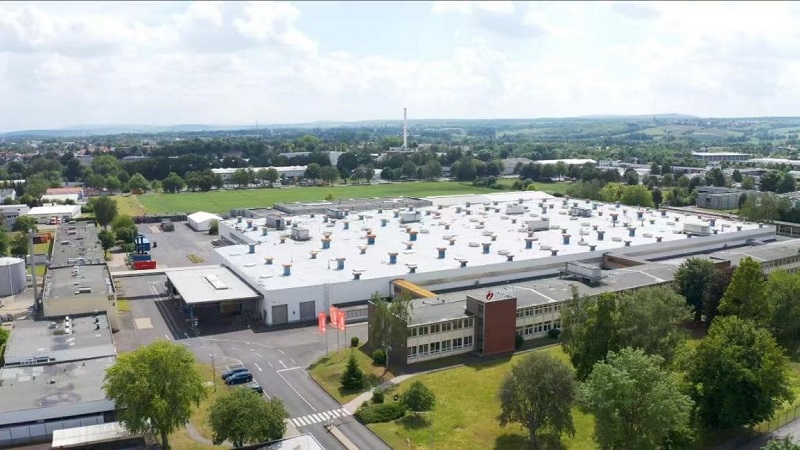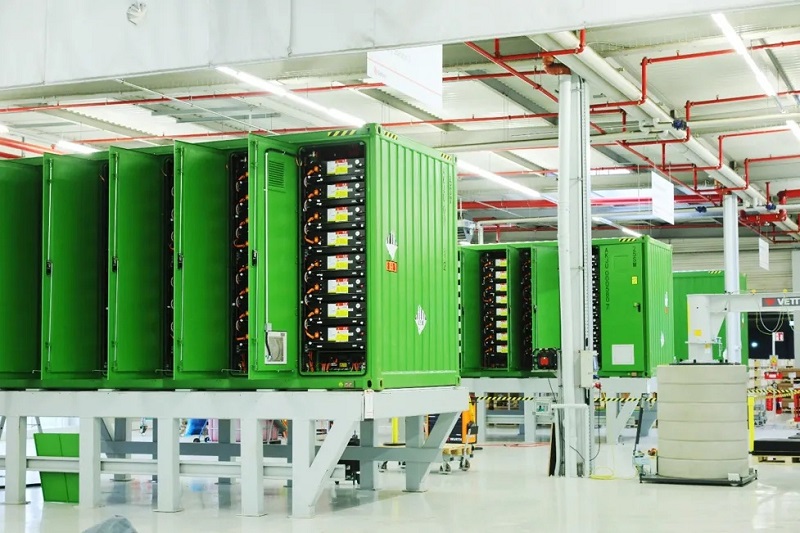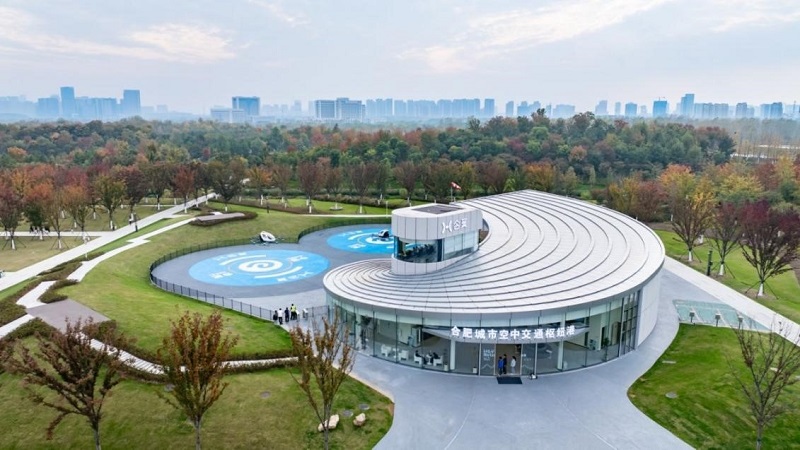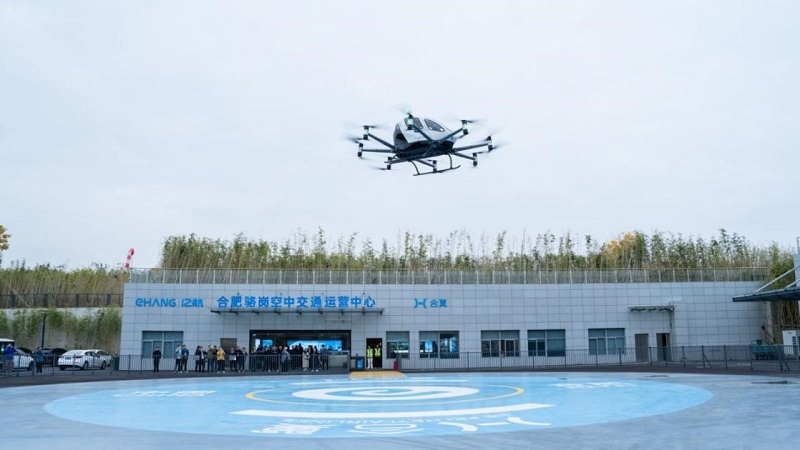Hefei, capital of east China’s Anhui Province and once an inconspicuous inland city, is being transformed into a “city of the future.”
From 2021 to 2025, the 14th Five-Year Plan period, Anhui Province has made notable progress in both technological innovation and strategic emerging industries. A good number of universities, national laboratories, and innovative enterprises have entered partnership, and a string of major scientific achievements have come to fruition. Hefei, Anhui’s capital and a hub of innovation, now leads in fostering new quality productive forces, deepening reform and opening-up. It is upgrading traditional industries while expanding strategic and future-oriented emerging fields such as new energy, new materials, aviation, aerospace, and the low-altitude economy. To improve the industrial ecosystem, the city continuously applies new technologies and products in new contexts and scales up emerging industries at a faster pace.

The headquarters of the Deep Space Exploration Laboratory (DSEL) in Hefei, Anhui Province.
Venturing Farther into Deep Space
Inside the Deep Space Exploration Laboratory (DSEL, or Tiandu Laboratory) headquartered in Hefei, a team working on in-situ utilization of extraterrestrial resources is running tests. Their self-developed “lunar-regolith 3D printing system” has taken a crucial step toward “using only on-site-sourced lunar soil to build human habitats on the moon.”
According to Yang Honglun, a senior engineer at the Future Technology Institute of DSEL, the lunar brick-making machine uses a parabolic reflector to concentrate solar energy, which is then transmitted via a fiber optic bundle. At the bundle’s terminus, the solar concentration ratio can exceed 3,000 times the normal intensity. A high-precision optical system then focuses this concentrated sunlight onto a small point, heating it beyond 1,300 degrees Celsius to melt lunar soil. The resulting bricks, fabricated entirely from in-situ lunar soil, exhibit high compressive strength and density, making them suitable for structural construction, equipment foundations, and even road surfaces in lunar infrastructure.

A researcher is operating the lunar-regolith 3D printer at the DSEL.
“The polar regions of the moon may contain significantly large amounts of water ice,” added Yang’s colleague engineer Zu Lin. “Once extracted, it can provide water and oxygen, and be split into hydrogen and oxygen for fuel, cutting the cost and risk of deep-space missions. Our goal is to exploit in-situ water, soil, and atmosphere to build an International Lunar Research Station with regolith bricks.”
The DSEL was co-founded on June 8, 2022, by the China National Space Administration (CNSA), Anhui Province, and the University of Science and Technology of China. It focuses on strategic, forward-looking, and fundamental research covering advanced power energy, deep space intelligent sensing and remote control, deep space tracking, telemetry and command, deep space resource utilization, and advanced materials.
In only three years, it has delivered a stream of “zero to one” breakthroughs. The back-to-back successes of China’s lunar and planetary exploration missions demonstrate the hard power of “Chinese technology,” while extensive international cooperation, technology exports, and open-access results build the soft power of a globally trusted “Chinese brand.”
So far, DSEL has signed cooperation agreements with more than 60 overseas research institutes, launched the annual International Deep Space Exploration Conference (Tiandu Forum), and initiated the International Deep Space Exploration Association (IDSEA), the first non-governmental global space science organization led by China and headquartered in Anhui. The Association already comprises 85 institutional members from over 30 countries and regions, and more than 600 scientists from over 60 countries.

China’s DSEL and its counterparts sign an agreement on the International Lunar Research Station (ILRS) Cooperation during the second International Deep Space Exploration Conference in Anhui Province, on September 5, 2024.
Wang Zhongmin, director of DSEL’s International Cooperation Center, told China Today, “By proposing and implementing projects such as the International Lunar Research Station and the International Earth-Moon Cube Constellation, China shoulders its responsibility as a major space power and promotes Chinese deep-space standards worldwide.”
He then gave an example of the International Earth-Moon Cube Constellation, which invites 50 countries to each build a small satellite, form a joint constellation, analyze data together, and share all results, a true embodiment of the vision of building a community with a shared future for humankind.
Looking ahead, DSEL is planning 10 deep-space strategic industries, including space energy and space tourism, and has already attracted a batch of commercial space companies and projects to Anhui, accelerating the transformation of deep-space achievements into local industries.
Making Green Energy Accessible and Sustainable
Gotion High-Tech, also headquartered in Hefei, is a front-runner in clean energy solutions. The company, recognized for its significant market share and innovative battery technologies, provides batteries for new-energy vehicles (NEVs), energy storage application, and power transmission and distribution equipment worldwide. Its products have been widely used on passenger, commercial, and special-purpose vehicles, while offering green-energy solutions to storage customers.

An aerial view of Gotion High-Tech’s Göttingen plant in Germany.
Xiong Yonghua, vice president of strategic business at Gotion High-Tech, told China Today that its competitive edge rests on end-to-end vertical integration in the Hefei economic circle, from mining in nearby Jiangxi Province’s Yichun, raw-material plants in Anhui’s Lujiang, and cell production in Hefei.
Anchoring R&D and manufacturing in China’s fully-integrated battery chain, Gotion sees the country as its “innovation highland and supply-chain backbone,” tapping mature technology-transfer channels and the world’s largest end-market to accelerate scale and cost leadership.
“At present, the domestic demand is stable, whereas overseas markets grow 70 to 80 percent annually. With global NEV parc (total number of vehicles in operation) projected to exceed 40 million by 2030, the company pursues a bigger market share, which covers China, the Asia-Pacific, the Americas, Europe, and Africa, by basing R&D in China while moving manufacturing closer to markets,” Xiong added.

The 5 MWh energy-storage system rolling off the production line at Gotion High-Tech’s Göttingen plant in Germany.
Since 2020 Gotion has partnered with Volkswagen Group, becoming its battery supplier in China in 2022, while maintaining long-term ties with multiple domestic carmakers and storage firms.
“Our strengths are cutting-edge technology, global footprint, diversified portfolio and localized supply chains,” said Xiong. Recycling capabilities in the Americas and Europe are being scaled up, closing the loop and building green, low-carbon or zero-carbon plants.
Besides Gotion’s German plant, its first European production base, with 20 GWh capacity, on October 28, the company inaugurated its Slovak gigafactory, the first in the country’s history. It also targets 20 GWh in phase one and plans to start production in 2027 for EU markets.
According to Xiong, the company’s household model, “Gotion Home 2.0” portable outdoor power station, delivers full-scenario coverage and has proved popular among European customers. Emerging scenarios, including light e-mobility, eVTOL aircraft for the low-altitude economy, humanoid robots, electric vessels, and smart-home energy, are building a “battery-plus” ecosystem.
A Flagship for “Context-Driven” Innovation
Luogang Park, sitting between Hefei’s old downtown and Binhu New District, is dubbed the “lung of Anhui.”
In November 2024, the Hefei Urban Air Mobility (UAM) Port, the country’s first urban air-traffic hub, opened inside the park. It integrates hangars, exhibition halls, conference rooms and a dispatch center. In the near future, passengers can buy tickets, pass security and board flights, hailing a “flying taxi.”
The port is operated by Hey Airlines, a joint venture between the municipal state-owned capital platform and EHang. Hey Airlines is Anhui’s first company devoted to the commercial UAM, pushing for conversion of aerial vehicles and scenario empowerment.

The Hefei UAM Port, the country’s first urban air-traffic hub, opens inside the Luogang Park in November 2024.
“The park’s 127,000 square meters of open space, coupled with the retained airspace identification from its previous airport status, provides ideal conditions for developing commercial contexts,” said Peng Sixuan, deputy general manager of Hey Airlines. An operation center inside the park provides maintenance and logistics, forming an integrated hub.
In March 2025, Hey Airlines received from the Civil Aviation Administration of China (CAAC) the world’s first Operator Certificate (OC) for unmanned passenger-carrying aircraft. This milestone certificate marks the official prelude to a “passenger-carrying era” of China’s low-altitude economy.
“Hey Airlines needs abundant low-altitude contexts,” Peng told China Today. The Hefei government is providing full-chain policy support for the company, spanning standard-setting, vertiport construction, and context expansion, and has assembled more than 300 low-altitude enterprises and opened 200-plus drone routes for medical supplies, rail inspection and food delivery.
In the future, Hey Airlines will manage multiple types of aircraft, becoming a diversified low-altitude operations platform for passenger shuttles, sightseeing, cargo, smart-city management, high-rise firefighting, emergency medical services, and industrial drone applications. It will also integrate hardware and software for eVTOL vertiports, offering digital turnkey solutions and striving to create a systematic, standardized and intelligent commercial operation model for unmanned passenger aircraft, setting a benchmark for contextual applications in the low-altitude economy.

A Hey Airlines’ eVTOL lands at the operation center inside the Luogang Park, which provides maintenance and logistics, forming an integrated hub.
“How can scientific research outcomes be efficiently commercialized? And how can enterprises find markets precisely? These depend on context-driven innovation,” said Yin Ximing, director of the Public Administration Department at Beijing Institute of Technology and member of the expert group for the 15th Five-Year Plan at the Ministry of Industry and Information Technology.
“From lab to industry, new technologies need open contexts for trial runs to turn future technologies into emerging industries,” Yin told China Today.
Throughout its innovation-led development, Hefei has stressed the guiding role of application contexts for the safe and sound growth of commercial space, low-altitude economy and other new industries. It pays special attention to how future contexts drive embodied AI, quantum technology, 6G and other frontier technologies, forging a virtuous cycle of “contexts drive tech innovation, new tech empowers industrial renewal, future industries keep emerging.” This context-driven deep integration of scientific and industrial innovation has become a powerful engine for cultivating new quality productive forces tailored to local conditions.